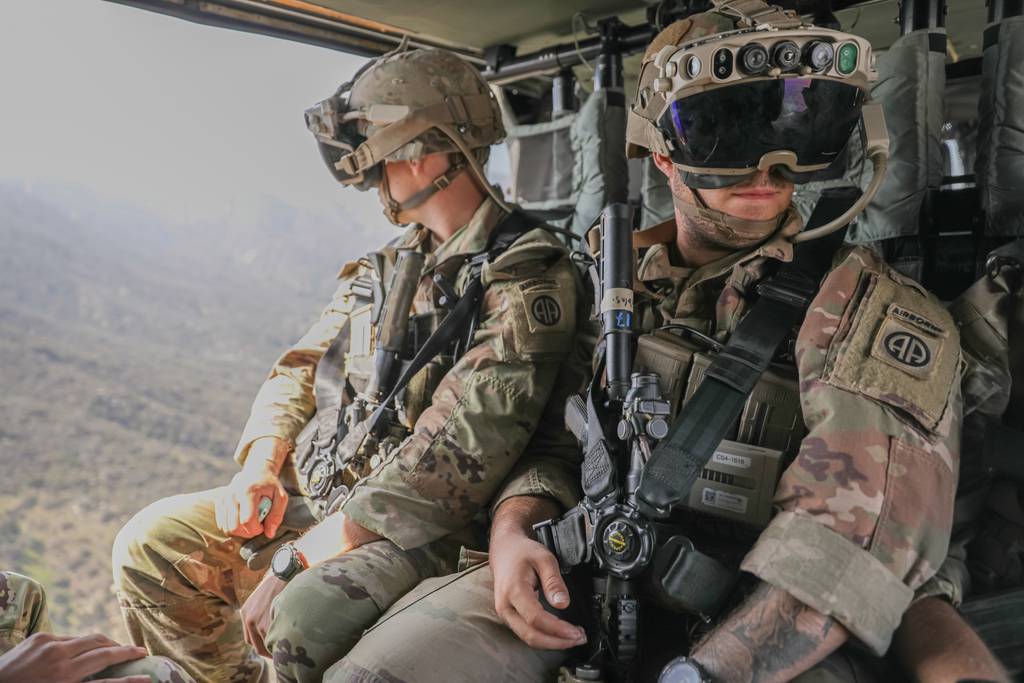The Army’s effort to give individual soldiers an augmented reality device that aims to improve shooting, navigation and use soldier-built applications for a host of tasks hits final testing phases in 2024.
The Integrated Visual Augmentation System, or IVAS, is a helmet-mounted combined night vision/thermal augmented reality and situational awareness tool the service is funding to the tune of $22 billion.
The Army procured early versions, labeled IVAS 1.0 and 1.1, in late 2022 as the more ruggedized, field-worthy 1.2 version continued development. Officials confirmed to Army Times that they had procured funding for 5,000 sets of IVAS 1.0 in 2022, and another 5,000 sets of IVAS 1.1 in 2023.
Those 1.0 and 1.1 versions are slated for training units and schoolhouses for soldiers to tinker with and learn best applications for the new technology.
Microsoft, which based the IVAS on its HoloLens augmented reality device, delivered 20 prototypes of IVAS 1.2 in mid-2023.
Soldiers with the 1st Brigade Combat Team, 10th Mountain Division at Fort Drum, New York tested the 1.2 in live fires for weapons compatibility checks in mid-August.
Another 80 such devices are scheduled for delivery in 2024 and a further 200 are slated for 2025 with fielding planned the same year, Program Executive Office-Soldier officials told Army Times.
The early HoloLens-based version of IVAS emerged in March 2019.
As teams developed the device, it transitioned from a helmet/no-helmet headstrap goggle option with a chest-mounted controller and thick cabling.
The cabling proved cumbersome for soldiers in various field tests.
Early testing showed image distortion and moisture control problems, which delayed testing by about a year but have since been resolved with software and hardware fixes, officials said.
The 1.2 version now has a flip-up, helmet mount, like many currently fielded night vision devices.

Key features of the device include its ability to link wirelessly to an individual’s weapon sight, allowing for picture-in-picture view from both the weapon-mounted camera and the device’s heads-up display.
In demonstrations at Fort Belvoir, Virginia, home to PEO-Soldier, the Family of Weapons Sights-Individual software used for the weapon-IVAS combination, allowed for users to see through obscurants, such as fog or dust, using thermal vision. Shooters were also able to fire around obstacles by using the weapon camera, while the shooter remains under cover
Navigation and training applications allow for users to lay out 3D maps of terrain, follow compass points in the heads-up display and identify friendly and enemy locations. In tactical scenarios, the device can load a “sand table” or internal map of a shoot house.
It also records position information as users move in teams, allowing for immediate after action reviews following shooting training.
Soldiers can use the IVAS to fly microdrones to scout a nearby location and take imagery of a target to send to its tactical cloud package, that then renders a 3D map of the terrain.
The cloud package runs on a briefcase-sized device used at the small unit level.
The IVAS also connects to the existing Nett Warrior smartphone-based Tactical Assault Kit. That device allows users to share information and upload various applications.
One example includes laying out fields of fire for a machine gunner that could be preloaded onto the device for when that soldier reaches the fighting position, said Brig. Gen. Christohper Schneider, PEO-Soldier commander.
Developers could create an app that provides a nine-line report for medical evacuations or an augmented reality option for medics to perform field surgery at the direction of a doctor at another location, he said.
Todd South has written about crime, courts, government and the military for multiple publications since 2004 and was named a 2014 Pulitzer finalist for a co-written project on witness intimidation. Todd is a Marine veteran of the Iraq War.








